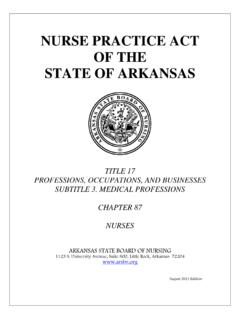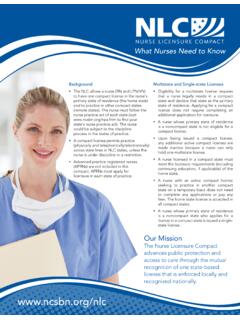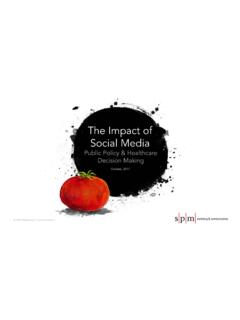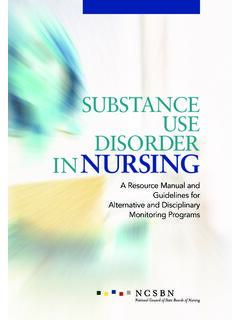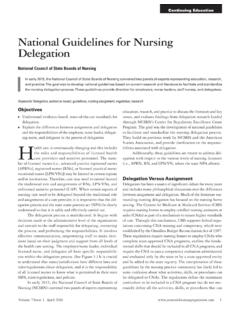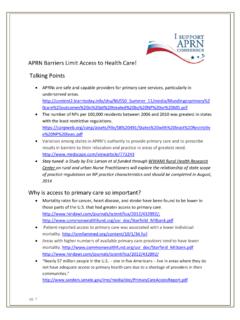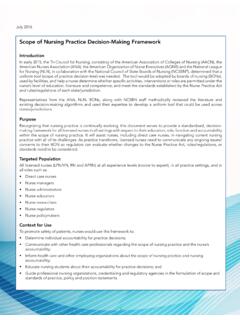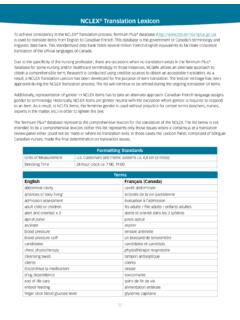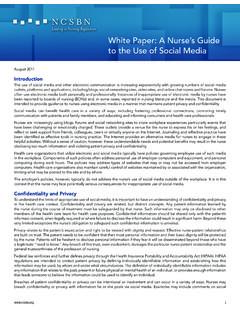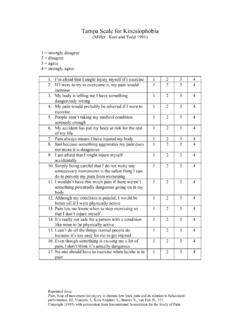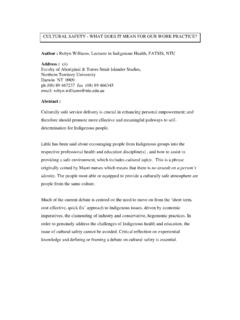Transcription of NCSBN Simulation Guidelines for Prelicensure Nursing ...
1 NCSBN Simulation Guidelines for Prelicensure Nursing Education and Purpose: The following Guidelines are meant to guide: of Nursing in evaluating the readiness of Prelicensure nursingprograms in using Simulation as a substitute for traditional clinical experience. education programs in the establishment of evidence basedsimulation programs for the undergraduate Nursing RN and LPN education programsGuideline DevelopmentAn expert panel consisting of representatives from International Nursing Association for Clinical Simulation and Learning (INASCL), American Association for Colleges of Nursing (AACN), National League for Nursing (NLN), Society for Simulation in Healthcare (SSH), Boards of Nursing and NCSBN developed the Guidelines based on data from the NCSBN National Simulation Study (2014), studies outlined in the following review of literature, the INACSL Standards of Best Practice: SimulationSM and other pertinent Panel Maryann Alexander, PhD, RN, FAANC hief Officer, Nursing RegulationNational Council of State Boards of Nursing Carol F.
2 Durham, EdD, RN, ANEF, FAANP rofessor of NursingDirector, Education-Innovation- Simulation Learning Environment (EISLE)School of NursingUniversity of North Carolina at Chapel HillPresident, International Nursing Association for Clinical Simulation and Learning (2013 2015)Nathan Goldman, JDGeneral CounselKentucky Board of NursingJanice I. Hooper, PhD, RN, FRE, CNEN ursing Consultant for EducationTexas Board of NursingPamela R. Jeffries PhD, RN, FAAN, ANEFP rofessor, School of NursingVice Provost of Digital InitiativesOffice of the ProvostRWJF Executive Nurse Fellow (ENF)Johns Hopkins UniversitySuzan Suzie Kardong-Edgren PhD, RN, ANEF, CHSEP rofessor and RISE Center DirectorSchool of Nursing and Health SciencesRobert Morris UniversityAdjunct Associate ProfessorDrexel College of MedicineKaren S. Kesten DNP, APRN, CCRN, PCCN, CCNS, CNED irector of Educational InnovationsAmerican Association of Colleges of NursingBeth Radtke, MSFormer Associate, Nursing RegulationNational Council of State Boards of NursingRichard Smiley, MS, MAStatisticianNational Council of State Boards of NursingElaine Tagliareni, EdD, RN, CNE, FAAN Chief Program Officer National League for NursingNancy Spector, PhD, RN, FAAN Director, Regulatory InnovationsNational Council of State Boards of NursingCrystal Tillman, DNP, RN, CPNPM anager - EducationNorth Carolina Board of ReviewA relatively large number of Nursing studies have been conducted analyzing the outcomes of Simulation in Prelicensure Nursing education, but limitations in sample size, a lack of randomization and absence of a control group limit them in their application towards building the science and providing sufficient evidence upon which to base policy.
3 There are, however, a number of systematic and integrative reviews that provide meaningful data for supporting Simulation as a learning pedagogy. Foronda, Liu & Bauman (2013) conducted an integrative review that included one hundred and one studies. In their synthesis of findings, they identified 5 major themes, including confidence/self-efficacy, satisfaction, anxiety/stress, skills/knowledge and interdisciplinary experiences. In the category of skills/knowledge, they included twenty-nine studies, reporting that the preponderance of the findings support Simulation to be effective for teaching knowledge and skills. For example, one research study cited in this review (Sportsman, Schumacker & Hamilton, 2011) was a longitudinal, descriptive investigation of 895 students, finding that students were able to learn unique skills and knowledge in Simulation that are normally learned in clinical , Levett-Jones, Bellchambers, & Fernandez (2010) conducted a systematic review of 8 studies that met their inclusion criteria.
4 They found that Simulation improved the critical thinking, performance of skills, knowledge of the subject matter and an increase in clinical reasoning in certain areas. Two integrative reviews of undergraduate Nursing s use of Simulation focused on patient safety. Berndt (2014) reviewed seventeen studies, including 3 systematic reviews. Their findings support the use of Simulation as an educational intervention to teach patient safety in Nursing , particularly when other clinical experiences aren t available. Fisher & King (2013) conducted an integrative review related to patient safety in that they examined eighteen studies preparing students, through Simulation , to respond to deteriorating patients. They found that, in general, confidence, clinical judgment, knowledge and competence increased through the use of Simulation . The largest and most comprehensive study to date examining student outcomes when Simulation was substituted for up to and including 50% Simulation was NCSBN s National Simulation Study (Hayden, Smiley, Alexander, Kardong-Edgren & Jeffries, 2014).
5 This longitudinal, randomized, controlled study replaced clinical hours with Simulation in Prelicensure Nursing education. In ten Nursing programs from across the country (5 BSN and 5 ADN), students were followed through all the clinical courses in their Nursing programs as well as through their first six months of practice. The study provides evidence that when substituting clinical experiences with up to 50% Simulation , there were no statistically significant differences between the groups using 10% or less of Simulation (control), 25% Simulation or 50% Simulation with regard to knowledge acquisition and clinical performance. In conclusion, the literature provides evidence that Simulation is a pedagogy that may be integrated across the Prelicensure curriculum, provided that faculty are adequately trained, committed and in sufficient numbers; when there is a dedicated Simulation lab which has appropriate resources; when the vignettes are realistically and appropriately designed; and when debriefing is based on a theoretical model.
6 5 The GuidelinesSimulation is a pedagogy that may be integrated across the pre-licensure curriculum; however, Nursing education programs are advised to begin slowly and steadily increase the amount of Simulation as they acquire expertise in this pedagogy. Questions have arisen regarding the number of clinical hours a program should require in order to substitute clinical hours with Simulation . All programs participating in the National Simulation Study required at least 600 hours of clinical experience in the pre-licensure curriculum. No evidence is available regarding the outcomes of substituting traditional clinical experience with Simulation when the program has less than 600 hours; however, experts agree that it is not the number of hours, but the quality of the experience.
7 If students are going to be placed in clinical settings where there is inadequate opportunity for hands-on experience, employment of Simulation by capable faculty with meaningful debriefing may offer a better addition to the Simulation Guidelines , Boards of Nursing and Nursing programs should consider the following criteria when determining the amount of Simulation that can substitute for traditional clinical hours:1. Overall number of clinical hours required by the program2. Pass rates of students3. Availability of clinical sites4. Turnover of faculty/program director5. Complaints from students6. Retention ratesDefinitionsSimulation: A technique, not a technology, to replace or amplify real experiences with guided experiences that evoke or replicate substantial aspects of the real world in a fully interactive manner (Gaba, 2004).Traditional Clinical Experience: Practice in an inpatient, ambulatory care or community setting where the student provides care to patients under the guidance of an instructor or 6 GuidelinesEvidence ResourcesThere is commitment on the part of the school for the Simulation program.
8 Letter of support from administrators stating the program has their support and will be given the resources to sustain the program on a long-term basis. Budgetary plan for sustainability and ongoing faculty training is in place. Written short-term and long-term objectives for integrating Simulation into the undergraduate curriculum and evaluating the Simulation has appropriate facilities for conducting simulationProgram has the educational and technological resources and equipment to meet the intended objectives A description describing the physical space for conducting simulations including the lab, storage/staging areas and a place for debriefing. Program has a plan that describes the Simulation resources and equipment that will be used to achieve the objectivesSee Scenario Resources DocumentLead faculty and sim lab personnel are qualified to conduct Simulation Submission of CVs and evidence of qualifications such as: Simulation conferences attended, coursework on Simulation instruction, certification in Simulation instruction, training by a consultant or targeted work with an experienced mentor SIRC Courses Simulation Preparation Programs Webinars and presentations based on INACSL Standards of Best Practice: Simulation CHSE Certification Three-Step Program at Boise State Textbooks: (Jeffries (2007) Simulations in Nursing Education: From Conceptualization to Evaluation Clinical Simulations: Advanced Concepts, Trends, and Possibilities.)
9 LWW and; Palaganas, , Maxworthy, , Epps, C. A., Mancini, (2015). Defining excellence in Simulation programs. Wolters KluwerFaculty are prepared to lead simulations See NCSBN Simulation Faculty Preparation ChecklistProgram has an understanding of polices and processes that are a part of the Simulation experience. Policies describing the following, include, but are not limited to: method of debriefing; plan for orienting faculty; qualifications of faculty and sim lab personnel; plan for training new faculty; evaluation methods. Socratic Method of Debriefing See NCSBN Program Preparation INACSL Standards of Best Practice: SimulationSimulation 7 Scenario Resources Document Quality and Safety Education for Nurses (QSEN) National League for Nursing (NLN) University of South Dakota Montgomery College-Maryland University of Washington Massachusetts Nursing Initiative NLN Simulation Innovation Resource Center (SIRC) 8 The Simulation program is based on educational theories associated with Simulation such as experiential learning theory.
10 The faculty are prepared by following the INACSL Standards of Best Practice: SimulationSM. A tool for evaluating Simulation -based learning experiences has been designed based on the INACSL Standards of Best Practice: Simulation evaluation methods. The program curriculum sets clear objectives and expected outcomes for each Simulation -based experience, which are communicated to students prior to each Simulation activity. The faculty are prepared to create a learning environment that encourages active learning, repetitive practice, and reflection, and to provide appropriate support throughout each activity. The faculty are prepared to use facilitation methods congruent with Simulation objectives/expected outcomes. The program utilizes a standardized method of debriefing observed Simulation using a Socratic methodology. A rubric has been developed to evaluate the students acquisition of KSAs (knowledge, skills and attitudes) throughout the program.
